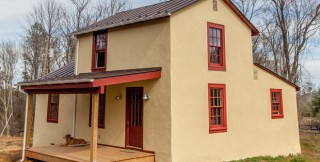Another man’s treasure: In Crozet, a farmhouse emerges from ruin – C-Ville Abode
Story by Erika Howsare
Back in the winter of 2012, the Mayan calendar supposedly predicted the end of the world. That didn’t happen, but big changes were about to come to one little farmhouse in Crozet. After years of neglect, it was totally obscured from view by vegetation. “You needed a hedge trimmer to get to the front door,” said Sean Carley, who bought the house and surrounding acreage as a retreat for himself and his family.
Carley, who’s based in Richmond, was attracted to the bucolic surroundings. “I love the land,” he said. “Crozet’s beautiful.” Mountain views notwithstanding, the look of things indoors was none too appealing. Built roughly at the turn of the last century, the house—a frame structure with a stucco exterior—was full of trash, had a porch smashed by fallen trees, and suffered from a broken water main.
Luckily, Carley nurtures an appreciation for historic homes and was familiar with the renovation process. “You can’t recreate that sort of character,” he said. He began spending weekends camping on the land and filling dumpsters with garbage. It was a big job: There were five fridges inside full of rotten food, and even the hand-dug well was full of trash and clothing.
The next step was to call in Lithic Construction. “I told Sean, ‘Let’s just clean it up,’” remembers Lithic’s Ned Ormsby, who couldn’t begin to estimate renovation costs until conditions were somewhat improved. After cleaning and gutting the house, the team realized that it was actually in good structural condition.
“Cosmetically it was in horrendous shape, but structurally we really didn’t do anything,” said Ormsby. “The roof is straight, and the walls are plumb.”
The place had a simplicity that was right for a weekend retreat. “I wanted to keep the integrity of the house,” said Carley. “I wanted wood pane windows and simple trim, and to salvage any beadboard we had.”
Lithic made few changes to the house’s basic plan. The footprint did not change. Inside, some doorways became wider and the two upstairs bedrooms reverted to a single, loftlike room. Yet the place was transformed with the addition of new windows, a sleek updated kitchen and fresh finishes throughout.
“We started trying to keep as much of the historic texture as possible,” Ormsby said. This meant, in places, creative reuse: Flooring in one spot had to be torn up to deal with termite damage, but the boards were planed and reclaimed as covering for the newly vaulted kitchen ceiling.
The stairway to the second floor is another spot that speaks to the past: What had been carpeted steps now reveal a rustic patina made of layers of old paint.
In the kitchen—which is surprisingly roomy for an 1,100-square-foot house—one long wall of workspace features a retro-look Aga gas stove, soapstone countertops, and slate-gray cabinets. An exposed brick chimney makes a clear connection to the past, while an apron-front sink is both up-to-the-minute and appropriate for the house’s vintage. Retro lighting fixtures came from Shades of Light.
The downstairs bedroom is modest and serene, with cool blue walls and white trim. The single bathroom features a 1925 clawfoot tub, plus a 1923 sink salvaged from Westover Plantation in Charles City—complemented by white subway tile on the walls and a tiny black-and-white tile pattern on the floor. Where interior doors needed replacing, the team found salvaged ones at Caravati’s in Richmond.
Upstairs, Carley’s 3- and 6-year-old children love the bunk beds in their cathedral-ceilinged loft with exposed joists. The family has been able to use the house for several months now, though plenty of details remain to be finished. “We’re in no rush,” Carley said. “It’s fun.”
On the exterior, Lithic has already built a completely new front porch and replaced the house’s roof. Landscape designers Water Street Studio helped choose the exterior colors: yellow for the stucco and brick red for the trim.
Undoubtedly, changes will come both inside and out. “I love imagining what this place will look like in 10 years,” said Carley. For now, he and his family are enjoying the newly refreshed cottage—a far cry from what stood here just over a year ago.
“So many people said, ‘Why don’t you just tear that down?’” remembered Ormsby. “You couldn’t have gotten anywhere near this character and quality [by building new]. And we saved a historic structure—never mind the environmental impact of not sending the whole thing to the dump.”




